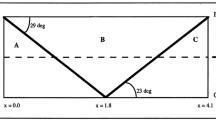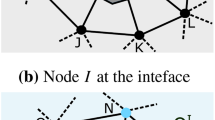Abstract
In the present work, an explicit finite element approach to the solution of the Lagrangian formulation of the Navier-Stokes equations for weakly compressible fluids or fluid-like materials is investigated. The introduction of a small amount of compressibility is shown to allow for the formulation of a fast and robust explicit solver based on a particle finite element method. Newtonian and Non-Newtonian Bingham laws are considered. A barotropic equation of state completes the model relating pressure and density fields. The approach has been validated through comparison with experimental tests and numerical simulations of free surface fluid problems involving water and water–soil mixtures.

















Similar content being viewed by others
References
Bao W, Jin S (2001) Weakly compressible high-order I-stable central difference schemes for incompressible viscous flows. Comput Methods Appl Mech Eng 190(37–38):5009–5026
Barlow AJ (2008) A compatible finite element multi-material ale hydrodynamics algorithm. Int J Numer Methods Fluids 56(8):953–964
Benson DJ (1992) Computational methods in Lagrangian and Eulerian hydrocodes. Comput Methods Appl Mech Eng 99(2–3):235–394
Bernard-Champmartin A, De Vuyst F (2014) A low diffusive lagrange-remap scheme for the simulation of violent air-water free-surface flows. J Comput Phys 274:19–49
Bernard-Champmartin A, Braeunig J-P, Ghidaglia J-ML (2013) An Eulerian finite volume solver for multi-material fluid flows with cylindrical symmetry. Comput Fluids 83:170–176. Numerical methods for highly compressible multi-material flow problems
Braeunig J-P, Desjardins B, Ghidaglia J-M (2009) A totally Eulerian finite volume solver for multi-material fluid flows. Eur J Mech B 28(4):475–485
Carbonell JM, Oñate E, Suarez B (2013) Modelling of tunnelling processes and cutting tool wear with the particle finite element method (PFEM). Comput Mech 52(3):607–629
Chen Z, Zong Z, Liu MB, Li HT (2013) A comparative study of truly incompressible and weakly compressible SPH methods for free surface incompressible flows. Int J Numer Methods Fluids 73(9):813–829
Cremonesi M, Ferrara L, Frangi A, Perego U (2010) Simulation of the flow of fresh cement suspensions by a lagrangian finite element approach. J Non Newton Fluid Mech 165:1555–1563
Cremonesi M, Frangi A, Perego U (2010) A lagrangian finite element approach for the analysis of fluid-structure interaction problems. Int J Numer Methods Eng 84:610–630
Cremonesi M, Frangi A, Perego U (2011) A lagrangian finite element approach for the simulation of water-waves induced by landslides. Comput Struct 89:1086–1093
Dobrev VA, Ellis TE, Kolev TV, Rieben RN (2011) Curvilinear finite elements for lagrangian hydrodynamics. Int J Numer Methods Fluids 65(11–12):1295–1310
Dobrev VA, Kolev TV, Rieben RN (2012) High-order curvilinear finite element methods for Lagrangian hydrodynamics. SIAM J Sci Comput 34(5):B606–B641
Edelsbrunner H, Mucke EP (1994) Three dimensional alpha shapes. ACM Trans Graph 13(1):43–72
Farhat C, Rallu A, Shankaran S (2008) A higher-order generalized ghost fluid method for the poor for the three-dimensional two-phase flow computation of underwater implosions. J Comput Phys 227(16):7674–7700
Franci A, Cremonesi M (2016) Critical investigation of the particle finite element method. Part I: Volume conservation with remeshing (submitted)
Galera S, Maire P-H, Breil J (2010) A two-dimensional unstructured cell-centered multi-material ALE scheme using VOF interface reconstruction. J Comput Phys 229(16):5755–5787
Heller V (2008) Landslide generated impulse waves: prediction of near field characteristics. VAW, Mitteilungen
Hughes TJR, Scovazzi G, Tezduyar TE (2008) Stabilized methods for compressible flows. J Sci Comput 43(3):343–368
Idelsohn SR, Mier-Torrecilla M, Oñate E (2009) Multi-fluid flows with the particle finite element method. Comput Methods Appl Mech Eng 198:2750–2767
Idelsohn SR, Oñate E, Del Pin F (2004) The particle finite element method: a powerful tool to solve incompressible flows with free-surfaces and breaking waves. Int J Numer Methods Eng 61:964–989
Idelsohn SR, Oñate E, Del Pin F, Calvo N (2006) Fluid-structure interaction using the particle finite element method. Comput Methods Appl Mech Eng 195:2100–2113
Idelsohn SR, Marti J, Limache A, Oñate E (2008) Unified lagrangian formulation for elastic solids and incompressible fluids: application to fluid-structure interaction problems via the pfem. Comput Methods Appl Mech Eng 197(19–20):1762–1776
Kamran K, Rossi R, Oñate E, Idelsohn SR (2013) A compressible lagrangian framework for modeling the fluid-structure interaction in the underwater implosion of an aluminum cylinder. Math Models Methods Appl Sci 23(02):339–367
Kamran K, Rossi R, Oñate E, Idelsohn SR (2013) A compressible lagrangian framework for the simulation of the underwater implosion of large air bubbles. Comput Methods Appl Mech Eng 255:210–225
Keshtiban IJ, Belblidia F, Webster MF (2004) Numerical simulation of compressible viscoelastic liquids. J Non Newton Fluid Mech 122(1–3):131–146
Komatina D, Jovanovic M (1997) Experimental study of steady and unsteady free surface flows with water-clay mixtures. J Hydraul Res 35(5):579–590
Koshizuka S, Tamako H, Oka Y (1995) A particle method for incompressible viscous flow with fluid fragmentation. Comput Fluid Mech J 113:134–147
Macdonald JR (1966) Some simple isothermal equations of state. Rev Mod Phys 38(4):669–679
Oñate E, Celigueta MA, Idelsohn SR, Salazar F, Suarez B (2011) Possibilities of the particle finite element method for fluid-soil-structure interaction problems. Comput Mech 48:307–318
Oñate E, Franci A, Carbonell JM (2014) A particle finite element method for analysis of industrial forming processes. Comput Mech 54:85–107
Oñate E, Rossi R, Idelsohn SR, Butler K (2010) Melting and spread of polymers in fire with the particle finite element method. Int J Numer Methods Eng 81(8):1046–1072
Oñate E, Franci A, Carbonell JM (2014) Lagrangian formulation for finite element analysis of quasi-incompressible fluids with reduced mass losses. Int J Numer Methods Fluids 74(10):699–731
Oñate E, Idelsohn SR, Del Pin F, Aubry R (2004) The particle finite element method. an overview. Int J Comput Methods 1:267–307
Papanastasiou TC (1987) Flows of materials with yield. J Rheol 31(5):385–404
Scovazzi G, Christon MA, Hughes TJR, Shadid JN (2007) Stabilized shock hydrodynamics: I. A lagrangian method. Comput Methods Appl Mech Eng 196(4–6):923–966
Scovazzi G, Love E, Shashkov MJ (2008) Multi-scale lagrangian shock hydrodynamics on q1/p0 finite elements: theoretical framework and two-dimensional computations. Comput Methods Appl Mech Eng 197(9–12):1056–1079
Shadloo MS, Zainali A, Yildiz M, Suleman A (2012) A robust weakly compressible SPH method and its comparison with an incompressible SPH. Int J Numer Methods Eng 89(8):939–956
Shao S, Lo EYM (2003) Incompressible SPH method for simulating newtonian and non-newtonian flows with a free surface. Adv Water Resour 26(7):787–800
Waltz J, Morgan NR, Canfield TR, Charest MRJ, Risinger LD, Wohlbier JG (2014) A three-dimensional finite element arbitrary Lagrangian-Eulerian method for shock hydrodynamics on unstructured grids. Comput Fluids 92:172–187
Xu X, Deng X-L (2016) An improved weakly compressible SPH method for simulating free surface flows of viscous and viscoelastic fluids. Comput Phys Commun 201:43–62
Author information
Authors and Affiliations
Corresponding author
Ethics declarations
Conflict of interest
The authors declare that they have no conflict of interest.
Rights and permissions
About this article
Cite this article
Cremonesi, M., Meduri, S., Perego, U. et al. An explicit Lagrangian finite element method for free-surface weakly compressible flows. Comp. Part. Mech. 4, 357–369 (2017). https://doi.org/10.1007/s40571-016-0122-7
Received:
Revised:
Accepted:
Published:
Issue Date:
DOI: https://doi.org/10.1007/s40571-016-0122-7




